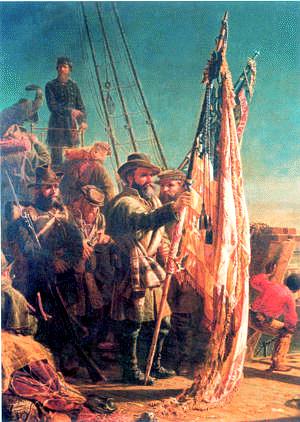
| Return of the Flags, 1865. Irish Brigade 63rd, 69th, 88th New York Infantry, Army of the Potomac, by Thomas Waterman Wood, a successful portrait painter best known for his paintings of nineteenth-century everyday life and African-Americans during the Civil War era. Wood's painting shows the Irish Brigade's return to New York City on July 3, 1865. The flags in the painting are not the Second Colors that the three New York regiments in fact carried back to New York City, but instead the First Colors. Perhaps because the First Colors led the regiments during the Fourth of July parade the next day, Wood assumed that they were also the colors that had led the regiments home to New York. Why Wood chose this subject matter for his 1869 painting is unknown. He painted another version years later, keeping the central character and the national flag but changing the locale to a railroad track passing under a viaduct, adding several African-American children, and eliminating the green flag altogether. The painting pictured here was acquired by the U.S. Military Academy in 1955 and now hangs at West Point. |
In July 1865 the three New York regiments of the Irish Brigade were mustered out of service. With the end of the war and the disbanding of the regiment came the question of what to do with its flags. General orders from the War Department instructed regiments to turn their flags over to their state governments. On July 4, 1865, representatives of the 63rd New York presented the governor in Albany with the fragment that remained of the national flag used during the campaigns of 1863 and 1864 — the Third National (1863 New York City) Colors. A month later, the Fourth National and Regimental (1865 New York City) Colors were deposited in Albany as well. A modern inventory records that there is a second regimental flag in the state's possession as well: logic would suggest it is the Third Regimental (1863 New York City) Colors, but that is at best only a guess. These flags today stand furled in the Capitol Building in Albany. Their condition is such that they cannot be unrolled and therefore cannot be further identified or analyzed. Until such time as these flags are stabilized and thus made available for study, some question will remain as to precisely which flags are in the capitol and what their condition is. The immediate disposition of the other flags is not known. They were evidently considered the property of the regiment, however, not of the government, and were therefore no doubt divided among the unit's officers. Colonel James D. Brady, the last commander of the 63rd, claimed the Second Irish (Tiffany) Colors and carried it back to his home state of Virginia. The First Irish Colors found its way into the flag collection of the 69th New York National Guard Armory in downtown New York; it is the only flag at the Armory today positively identified as belonging to the 63rd. The present whereabouts — or even the continued existence — of the First National Colors, the First Regimental Colors, and the Second National (Tiffany) Colors are unknown; they were all lost to history at the end of the war. But the present location of the flag Colonel Brady took home, the Second Irish (Tiffany) Colors, is precisely known: it is found in the Archives of the University of Notre Dame. |
- 15 -